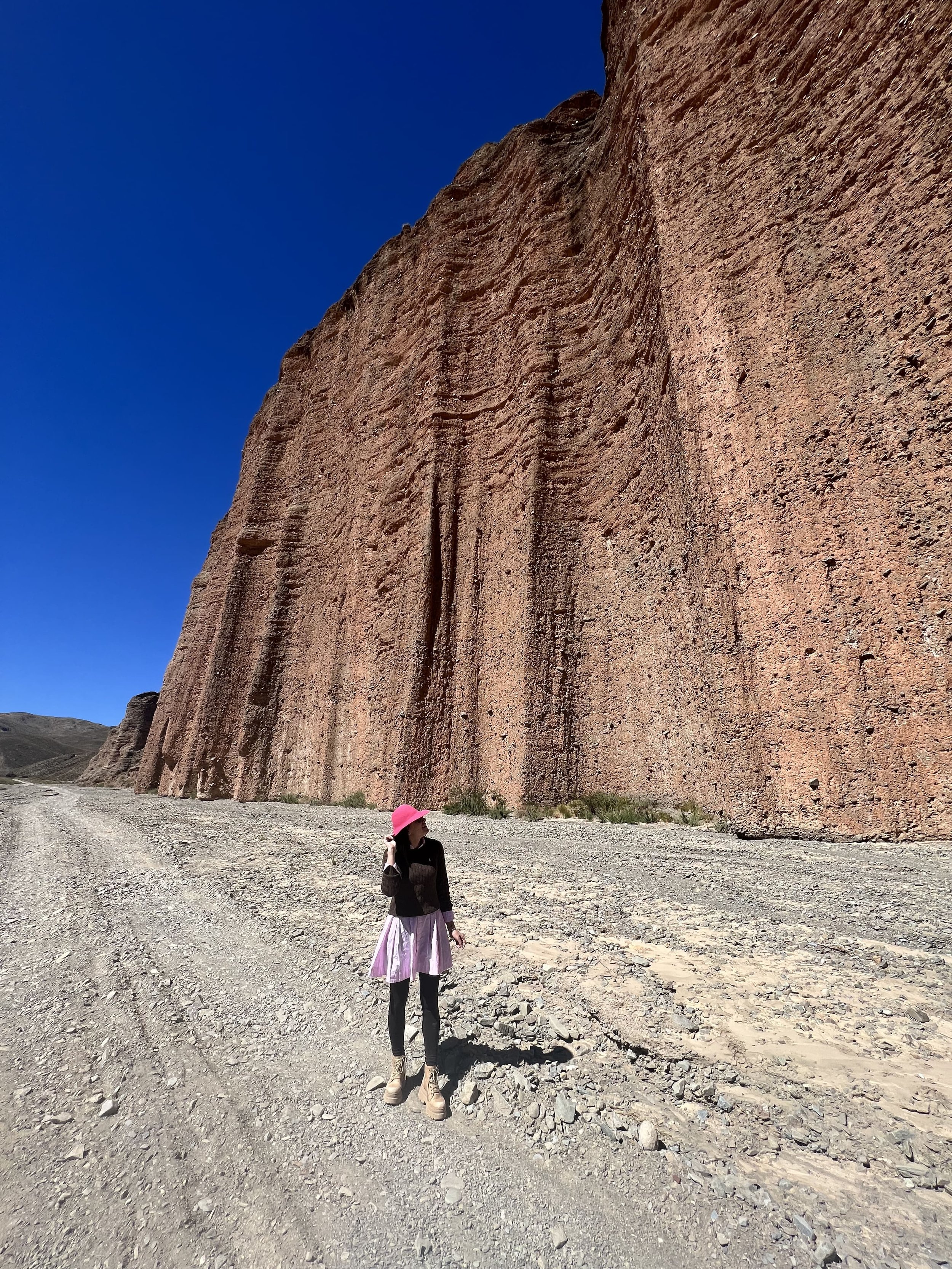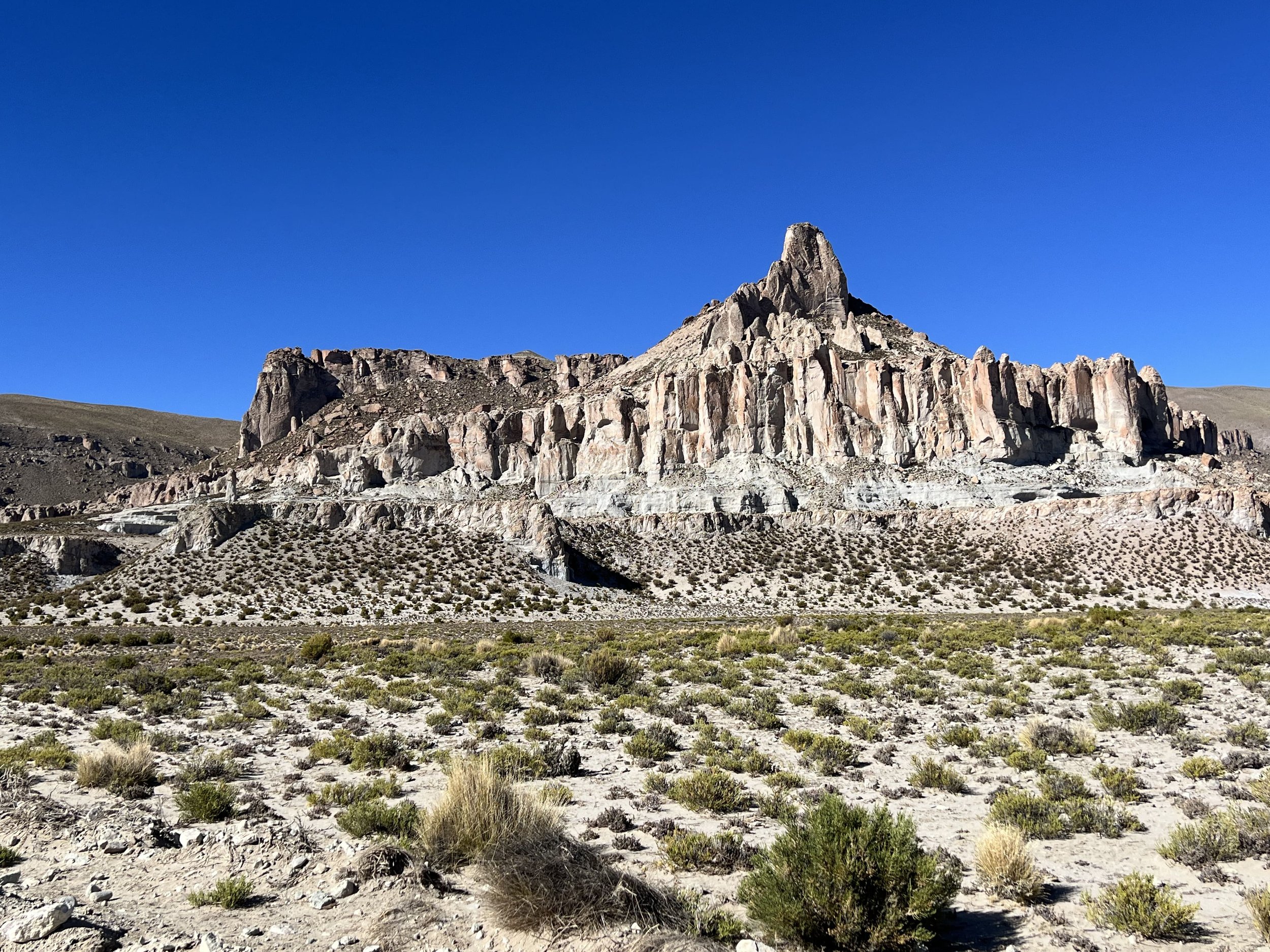Route 40's final stretch
Arduous road of puna and lonelinessWe started our journey from La Quiaca. The idea was to visit the Farallón de Cabrería and Cusi Cusi, with its impressive Valle de la Luna (Valley of the Moon).
We spent the first night at Refugio Del Sol, a good lodge in the center of La Quiaca that provided hot water, private bathroom and a very generous breakfast before leaving.
When we took the beginning -actually the end depending on the mileage- of the mythical national route 40, a lady signaled us to slow down. She wanted to ask us for a ride to Puesto Grande. Of course, we did not hesitate to accept, so Mabel and all her belongings climbed into the truck, the Hilux model 2007 that made us know the remote villages of northern Argentina.
On the way she told us that she had never been to Cusi Cusi, being from Santa Catalina, and how much she would like to be able to do it.
During the almost one hour trip she shared her story. She was going to spend the weekend with her husband, who had been entrusted with the care of some sheep in Puesto Grande.
We passed through several places with very few inhabitants, one of those typical of the north that look abandoned. So, first it was Tafna with its old chapel, then we crossed the Cuesta de Toquero, Cieneguillas and Puesto Grande. When we arrived, she told us where to stop, in the distance her husband was working as a shepherd with about a hundred sheep. She said goodbye, but not before asking how much he owed us. Without believing it -of course- we answered nothing. We greeted each other and wished each other a good life.
We continued on our way to Santa Catalina, the second northernmost town in Argentina, almost on the border with Bolivia.
Its church stands out in this immaculate town of adobe houses; dedicated to the veneration of Santa Catalina de Alejandría, its wide mud walls denote its four centuries of antiquity.
In town, one lodging option is Felisa Solís' Hostería Don Clemente.
We continue along the 40 on a typical stretch of the puna, until we took the detour to know the Farallón de Cabrería. To do so, we took Provincial Route 64 to Oratorio and from there another stretch to the Farallón.
It is a great wall about a hundred meters high; a natural wall in the middle of nowhere.
It is accessed after a rather complicated road, a steep path that requires 4 × 4 vehicles and intrepid drivers, then crossing the rocky bed of the Cabrería River.
We wanted to visit El Farallón as a way of paying homage to the great chef we met in San Juan province. Alfredo Morales was born there, in Cabrería, made his way and settled in the Cuyo province. The great chef in charge of Pa' Pueblo, who made us live one of those gastronomic experiences that will remain forever in our memories.
Now, the destination is remote and difficult to access, as to take it well into account before going. But once there, to appreciate the beauty of that wall carved by the water of the melting river and by time, which never seems to pass in that desolate place, is moving.
From Farallón we continue south, through a completely desolate shortcut, towards San Juan y Oros, where we returned to the 40 towards Paicone, the next town.
In this stretch the road turns into the bed of the Quebrada de Paicone river. It is a truly tortuous eleven kilometers, with a lot of movement on the cobblestone road that is a test for the shock absorbers. On the other hand, the view offered by this stretch is really amazing, because the road is boxed to the bed between large rock walls and hills very striking.
The small village of San Juan y Oros, or rather hamlet, seems abandoned from afar and soon caught our attention. We decided to stop in front of its old church to thank the divine of the universe for having arrived there and to continue on our way with our body organs more or less in their place, after the tremendous rattling that the circuit turned out to be.
After this uncertain, lonely and arduous route, we finally arrived at the impressive Valle de la Luna, very close to the town of Cusi Cusi.
There is a viewpoint on the side of Route 40 and another on the road into town. Both are very beautiful, but if you have to choose only one, keep in mind how the sun impacts the colors of the valley. Thus, the viewpoint on route 40 is more convenient for a visit before noon when the sun illuminates the west; on the other hand, in the afternoon, it is preferable to enter the road towards the village to have the view of that other viewpoint, when the sun begins to go to bed in the Cordillera shining in the east.
We continued walking a little more and, at that moment, a group of llamas that were being herded by the herdsmen caught our gaze. We stopped because the scene was from another time and deserved to be witnessed. We got off and when we asked, the owner of the cattle, Mr. Condorí, told us that he and his family were dedicated, that May 1st holiday, to the task of choosing the llama to be slaughtered. When we asked him, his words were "we are about to make meat". The children of the house were happy when before leaving we gave them chips and candy. In this regard, a recommendation, in the puna always, but always, bring a supply of candy or children's magazines to share at the stops along the way.
On the other hand, on the puna routes it is very common to come across animals: llamas and vicuñas in general; foxes, condors and guanacos the luckiest ones; and pumas the few privileged by the goddess of fortune. In this case, seeing the llamas all together, with their yellow & fuchsia markings was quite a surprise.
As we were driving along the road we met the other kind of worship, some suris. They always walk in pairs. When they saw us, with their natural agility left, camouflaging themselves on the slopes.
Then came a stage of spectacular scenery, somewhat similar to the Juguetería in Sey, in the stage of Route 40 between Susques and San Antonio de los Cobres, where the rocks expelled by the volcanoes in the area were scattered on the hillside and the road winds between them.
Then we pass through Liviara and Orosmayo; the story goes that as a result of a dispute between father and son, the latter left Orosmayo forever and settled in Liviara, giving birth to the new town.
From there to Pirquitas mine the road is in very good conditions since the mining companies maintain it in impeccable form.
The next town is -in fact- Mina Pirquitas, which from the road looks like a big city, in comparison with the previous ones, especially because of the big installations of the mining company. An important Inca exploitation used to be located there and today it holds, according to its inhabitants, the altitude record for an Argentinean town: 4270 meters above sea level. The phone's GPS, at the access to the new Pirquitas, gave us 150 less.
It is followed by the picturesque village of Coyaguaima, which means "very old coya". In this section the road conditions are again very hard and very unsuitable for low vehicles, with crossings of melting streams that in summer can be an insurmountable obstacle. In addition, there is a lot of calamine and the kidneys and waistlines suffer from it.
And in that, we meet again a couple of suris, in the middle of the road. All a kindness of chance.
The herds of llamas were at ease, everywhere, along the Abra Grande, which with its more than 4,400 meters marks one of the many ceilings of the journey.
Just before Coranzulí, there was a sign indicating hot springs. There we were told that at the town's municipal commission we could ask for the keys to take a comforting bath in the pools.
In the village we bought two soft drinks at Dubai prices and prepared a picnic on the banks of the Blanco river, already at the exit.
Continuing along another high pass, we could see the Salinas Grandes in the distance. A very nice postcard.
And finally we arrived at Susques, which is getting bigger and bigger because of the many mining companies around it, achieving the goal of traveling this arduous part of Route 40, in which, except for the stretch near Mina Pirquitas, the rest of the road is totally desolate and wild, typically Puna.






























